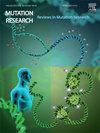mettl14介导的m6A修饰ETV4抑制结直肠癌的肿瘤发展
IF 1.9
4区 医学
Q4 BIOTECHNOLOGY & APPLIED MICROBIOLOGY
Mutation Research-Fundamental and Molecular Mechanisms of Mutagenesis
Pub Date : 2025-06-11
DOI:10.1016/j.mrfmmm.2025.111910
引用次数: 0
摘要
许多m6A甲基转移酶已被确定调节结直肠癌(CRC)的进展。METTL14已被证实在CRC过程中发挥负向作用,但其调控CRC进展的分子机制有待进一步阐明。方法采用qRT-PCR和western blot检测各组小鼠METTL14、YTHDF2和ETS易位变异体4 (ETV4)的表达水平。采用集落形成实验和流式细胞术检测细胞增殖和凋亡情况。通过检测相应指标评价细胞糖酵解。通过测定SOD、MDA、GSH、ROS、Fe2 +水平评价细胞铁下垂。通过RIP实验和RNA下拉实验证实了ETV4与METTL14或m6A读取器的相互作用。动物实验证实了METTL14在体内的作用。结果mettl14在结直肠癌组织和细胞中表达下调,其过表达抑制结直肠癌细胞增殖和糖酵解,促进结直肠癌细胞凋亡和铁凋亡。METTL14通过m6A修饰降低ETV4 mRNA的稳定性,抑制ETV4蛋白的表达。m6A读卡器YTHDF2可以识别m6A甲基化的ETV4。METTL14下调ETV4导致CRC细胞凋亡和铁凋亡增加,提示其在肿瘤抑制中起关键作用。此外,METTL14通过降低ETV4的表达在体内抑制CRC的肿瘤发生。结论mettl14通过下调ETV4以m6a依赖的方式加速结直肠癌细胞凋亡和铁凋亡,为结直肠癌治疗提供了分子靶点。本文章由计算机程序翻译,如有差异,请以英文原文为准。
METTL14-mediated m6A modification of ETV4 inhibits tumor development in colorectal cancer
Background
Many m6A methyltransferases have been identified to regulate colorectal cancer (CRC) progression. METTL14 has been confirmed to play a negative role in CRC process, but the molecular mechanism of METTL14 in regulating CRC progression needs to be further elucidated.
Methods
The levels of METTL14, YTHDF2 and ETS translocation variant 4 (ETV4) were examined by qRT-PCR and western blot. Cell proliferation and apoptosis were determined by colony formation assay and flow cytometry. Cell glycolysis was assessed by detecting corresponding indicators. Cell ferroptosis was evaluated via measuring SOD, MDA, GSH, ROS and Fe2 + levels. The interaction between ETV4 and METTL14 or m6A readers was confirmed by RIP assay and RNA pull-down assay. Animal experiments were performed to confirm METTL14 roles in vivo.
Results
METTL14 was downregulated in CRC tissues and cells, which overexpression inhibited proliferation and glycolysis, as well as promoted apoptosis and ferroptosis in CRC cells. METTL14 reduced the mRNA stability of ETV4 and inhibited ETV4 protein expression through m6A modification. m6A reader YTHDF2 could recognize m6A-methylated ETV4. The downregulation of ETV4 by METTL14 leads to increased apoptosis and ferroptosis in CRC cells, suggesting a critical role in tumor suppression. Moreover, METTL14 inhibited CRC tumorigenesis in vivo via reducing ETV4 expression.
Conclusion
METTL14 accelerated CRC cell apoptosis and ferroptosis via downregulating ETV4 in m6A-dependent manner, providing a molecular target for CRC treatment.
求助全文
通过发布文献求助,成功后即可免费获取论文全文。
去求助
来源期刊
CiteScore
4.90
自引率
0.00%
发文量
24
审稿时长
51 days
期刊介绍:
Mutation Research (MR) provides a platform for publishing all aspects of DNA mutations and epimutations, from basic evolutionary aspects to translational applications in genetic and epigenetic diagnostics and therapy. Mutations are defined as all possible alterations in DNA sequence and sequence organization, from point mutations to genome structural variation, chromosomal aberrations and aneuploidy. Epimutations are defined as alterations in the epigenome, i.e., changes in DNA methylation, histone modification and small regulatory RNAs.
MR publishes articles in the following areas:
Of special interest are basic mechanisms through which DNA damage and mutations impact development and differentiation, stem cell biology and cell fate in general, including various forms of cell death and cellular senescence.
The study of genome instability in human molecular epidemiology and in relation to complex phenotypes, such as human disease, is considered a growing area of importance.
Mechanisms of (epi)mutation induction, for example, during DNA repair, replication or recombination; novel methods of (epi)mutation detection, with a focus on ultra-high-throughput sequencing.
Landscape of somatic mutations and epimutations in cancer and aging.
Role of de novo mutations in human disease and aging; mutations in population genomics.
Interactions between mutations and epimutations.
The role of epimutations in chromatin structure and function.
Mitochondrial DNA mutations and their consequences in terms of human disease and aging.
Novel ways to generate mutations and epimutations in cell lines and animal models.

 求助内容:
求助内容: 应助结果提醒方式:
应助结果提醒方式:


